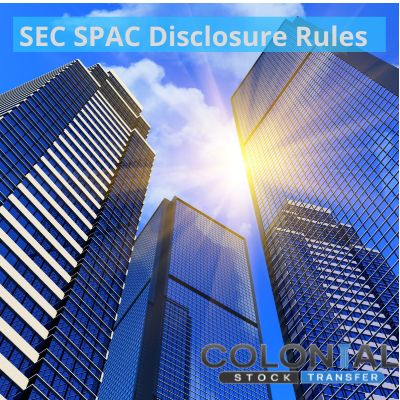
In a landmark move, the U.S. Securities and Exchange Commission (SEC) introduced a comprehensive set of rules to enhance investor protections. These new regulations focus on Special Purpose Acquisition Companies (SPACs), shell companies, and the disclosure of financial projections. The objective is to align investor safeguards with the evolving landscape of the financial markets, ensuring that all participants operate under a framework of enhanced disclosure and integrity.
Overview of the SEC’s New Regulatory Enhancements
- Enhanced Disclosures for SPACs and Shell Companies: The SEC mandates more detailed disclosures regarding SPAC sponsors, conflicts of interest, and the financial health of target companies. These disclosures are designed to provide investors with a comprehensive understanding of the investment vehicle’s structure and risks.
- Alignment with Traditional IPO Standards: The new rules seek to ensure that SPAC IPOs adhere to the same rigorous standards as traditional initial public offerings. This includes stricter scrutiny of financial statements and business projections.
- Increased Legal Liabilities: Target companies involved in de-SPAC transactions must now assume co-registrant status, sharing responsibility for the accuracy of disclosures. This change is anticipated to elevate the quality of information available to investors, reducing the risk of misinformation.
- Restrictions on Safe Harbor Provisions: The SEC’s rules limit the use of the Private Securities Litigation Reform Act’s safe harbor for forward-looking statements for SPACs and certain other companies. This move is intended to discourage overly optimistic projections and ensure that investors have access to realistic financial forecasts.
- Implementation and Compliance Timeline: The SEC has set a clear timeline for the adoption of these new regulations, providing market participants with sufficient time to adjust their practices. This phased approach aims to facilitate a smooth transition to the new regulatory framework, minimizing disruption to the financial markets.
Aligning SPAC IPOs with Traditional IPO Standards
The SEC’s regulations introduce a paradigm shift, ensuring that SPAC IPOs are now subject to the same level of scrutiny as traditional IPOs. This alignment is critical in safeguarding investor interests, as it subjects SPACs to rigorous evaluation of their financial health, business model, and growth prospects. By doing so, the SEC aims to level the playing field, ensuring that all entities entering the public market meet high standards of transparency and accountability.
Furthermore, this alignment is expected to foster greater confidence among investors. Knowing that SPAC IPOs undergo a thorough examination and adhere to stringent disclosure requirements, investors can make decisions based on reliable and comprehensive information.
The Role of Enhanced Disclosures in Investor Protection
Enhanced disclosures serve as the cornerstone of the SEC’s investor protection strategy. By providing investors with a clear and comprehensive view of the investment vehicle, its management, and its business prospects, the SEC aims to empower investors to make informed decisions. This level of transparency is essential in building trust in the financial markets, particularly in segments that have historically been less transparent, such as SPACs and shell companies.
Furthermore, these disclosures play a vital role in leveling the playing field. They ensure that all market participants, regardless of their level of sophistication, have access to the information necessary to understand the risks and rewards associated with their investments.
SPAC Sponsors and Conflict of Interest Disclosures
The SEC’s new rules emphasize the disclosure of potential conflicts of interest, particularly concerning SPAC sponsors. This focus aims to shed light on the intricate web of relationships and incentives that may affect the decision-making process within these entities. By requiring detailed disclosures of these potential conflicts, investors can better understand the motivations behind key decisions and assess their impact on shareholder value.
In addition, the rules highlight the importance of transparency in compensatory arrangements and affiliations between SPAC sponsors and their associates. This information is crucial in evaluating the alignment of interests between SPAC management and investors. Through these disclosures, the SEC seeks to ensure that investors are aware of any factors that may influence the integrity of their investment.
Legal Liabilities and the Co-Registrant Requirement
One of the most significant changes introduced by the SEC is the co-registrant requirement for target companies in de-SPAC transactions. This requirement subjects these companies to the same legal liabilities as the SPAC, ensuring that both parties are equally accountable for the accuracy of disclosures. This shared responsibility is expected to improve the quality of information available to investors, reducing the likelihood of fraud and misinformation.
The introduction of this requirement also signifies a shift towards greater accountability in the SPAC ecosystem. By holding target companies to a higher standard of disclosure, the SEC aims to protect investors from the risks associated with opaque or misleading information.
Rule 145a: Redefining Shell Company Transactions
Rule 145a represents a pivotal change in the treatment of business combinations involving shell companies. By classifying these transactions as sales of securities, the SEC requires them to undergo the same registration process as traditional securities offerings. This classification aims to enhance transparency and investor protection by subjecting these transactions to the rigorous scrutiny of the registration process.
The rule revises financial statement requirements for transactions involving shell companies, aligning them with the standards applicable to traditional IPOs. This alignment ensures that investors have access to accurate and comprehensive financial information, enabling them to make informed investment decisions.
Transparency in Financial Projections: A New Era
The SEC’s new rules usher in a new era of transparency in financial projections. By requiring detailed disclosure of the bases and assumptions underlying projections, the SEC aims to provide investors with a clearer understanding of their investments’ potential risks and rewards. This level of detail is crucial in enabling investors to evaluate the realism and credibility of financial forecasts.
Furthermore, the rules restrict the use of safe harbor provisions for forward-looking statements by SPACs and other specified entities. This restriction is designed to prevent the dissemination of overly optimistic or speculative projections, ensuring investors can access balanced and reasonable financial forecasts. Through these measures, the SEC seeks to foster a more transparent and accountable environment for financial projections, enhancing investor protection.
A Detailed Comparison: Old Rules Versus New
| Aspect | Old Rules | New Rules |
| Disclosures | Limited disclosures required | Enhanced disclosures on conflicts, finances, etc. |
| SPAC IPO Standards | Less stringent compared to traditional IPOs | Aligned with traditional IPO standards |
| Legal Liabilities | Primarily on SPACs | Co-registrant requirement for target companies |
| Safe Harbor for Projections | Broadly available | Restricted for SPACs and certain entities |
| Financial Projections | Less rigorous requirements | Detailed bases and assumptions required |
| Shell Company Transactions | Looser regulations | Classified as sales of securities, stricter rules |
| Compliance Timeline | Not specifically defined | Clear timeline established |
| Investment Company Classification | Not explicitly addressed | Clarification on SPACs as potential investment companies |
Navigating the New Regulatory Landscape: Advice for Market Participants
For market participants, navigating the new regulatory landscape will require a strategic and informed approach. Becoming familiar with the nuances of the new rules is the first step towards ensuring compliance and leveraging the opportunities these changes present. Adapting to the enhanced disclosure requirements and legal liabilities will be crucial for maintaining integrity and investor trust in this evolving market. Those who are proactive about ensuring compliance with the new rules now will have a competitive advantage in the changing financial market landscape.



